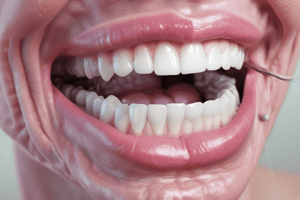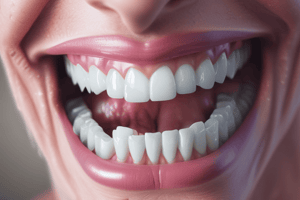Podcast
Questions and Answers
What is the most common location for osteosarcoma in the jaw?
What is the most common location for osteosarcoma in the jaw?
- Anterior maxillofacial region
- Mandible (correct)
- Maxilla
- Palate
Which type of tumor is characterized by the formation of an osteoid matrix?
Which type of tumor is characterized by the formation of an osteoid matrix?
- Burkitt’s lymphoma
- Ewing’s sarcoma
- Osteosarcoma (correct)
- Chondrosarcoma
What demographic is primarily affected by Ewing's sarcoma?
What demographic is primarily affected by Ewing's sarcoma?
- Middle-aged individuals
- Children and young adults (correct)
- Infants
- Older adults
Which of the following conditions is associated with osteosarcoma occurrence?
Which of the following conditions is associated with osteosarcoma occurrence?
What characteristic feature is observed in Grade I chondrosarcoma?
What characteristic feature is observed in Grade I chondrosarcoma?
What is the most common location for ossifying fibroma?
What is the most common location for ossifying fibroma?
What type of bone lesions can be treated with neoadjuvant chemotherapy followed by surgery?
What type of bone lesions can be treated with neoadjuvant chemotherapy followed by surgery?
Which of the following is true about osteoid osteoma?
Which of the following is true about osteoid osteoma?
What is a characteristic feature of fibrous dysplasia?
What is a characteristic feature of fibrous dysplasia?
What type of tumors does hemangioma most often resemble?
What type of tumors does hemangioma most often resemble?
Which bone tumor is often categorized as malignant and can show hematogenous metastasis?
Which bone tumor is often categorized as malignant and can show hematogenous metastasis?
Which histological feature is associated with Langerhans cell histiocytosis?
Which histological feature is associated with Langerhans cell histiocytosis?
What is a common clinical feature of osteoblastoma?
What is a common clinical feature of osteoblastoma?
What distinguishes a torus and exostosis from other bone tumors?
What distinguishes a torus and exostosis from other bone tumors?
Why is it important to treat malignant tumors like osteosarcoma and Ewing's sarcoma early?
Why is it important to treat malignant tumors like osteosarcoma and Ewing's sarcoma early?
Flashcards
Exostosis
Exostosis
A bony protrusion on the outer surface of the alveolar bone, most commonly located in the buccal region.
Osteosarcoma
Osteosarcoma
A type of bone cancer that originates from bone-forming cells. It is characterized by the formation of osteoid (immature bone) and may also include other tissue components like cartilage or fibrous tissue.
Chondrosarcoma
Chondrosarcoma
A malignant tumor originating from cartilage cells. It is characterized by the formation of cartilage tissue with varying degrees of cellular abnormalities.
Ewing's Sarcoma
Ewing's Sarcoma
Signup and view all the flashcards
Burkitt's lymphoma
Burkitt's lymphoma
Signup and view all the flashcards
Ossifying Fibroma
Ossifying Fibroma
Signup and view all the flashcards
Fibrous Dysplasia
Fibrous Dysplasia
Signup and view all the flashcards
Osteoblastoma
Osteoblastoma
Signup and view all the flashcards
Osteoid Osteoma
Osteoid Osteoma
Signup and view all the flashcards
Aneurysmal Bone Cyst
Aneurysmal Bone Cyst
Signup and view all the flashcards
Hemangioma
Hemangioma
Signup and view all the flashcards
Langerhans Cell Histiocytosis
Langerhans Cell Histiocytosis
Signup and view all the flashcards
Osteoma
Osteoma
Signup and view all the flashcards
Chondroma
Chondroma
Signup and view all the flashcards
Torus and Exostosis
Torus and Exostosis
Signup and view all the flashcards
Study Notes
Non-Odontogenic Bone Tumors
- Non-odontogenic bone tumors are those that do not originate from tooth structures.
- Evaluating bone pathology requires age, localization, and radiographic findings.
- A thorough clinical history significantly improves diagnosis accuracy.
- Multidisciplinary evaluation, including a bone council, is often recommended.
- Malignant tumors often exhibit hematogenous metastases (e.g., to the lung) which are often noted rather than local spread/distant metastases.
- Correct diagnosis and treatment are important
- For benign conditions, the most common treatment is curettage plus grafting.
- Some malignant conditions can be treated by neoadjuvant CT+surgery (OS) or Ewing's Sarcoma and CT/RT therapy for lymphoma, myeloma.
- Surgery alone is the treatment for low-grade conditions like OS, chondrosarcoma.
Benign Bone Tumors
- Ossifying Fibroma: Slow-expanding, typically found in the jaw near teeth, affecting 30-40-year-olds. Bone matrix forms in fibrous tissue.
- Fibrous Dysplasia: Fibrous tissue causes bone metaplasia, typically in the maxilla. The condition is characterized by slow expansion and deformity. Often shows up in the 10-20-year-old age group and is frequently monostotic or polyostotic, sometimes causing craniofacial fibrous dysplasia
- Osteoblastoma: Rare condition; located most often in the mandible; posterior tooth area; causes pain; typically a lytic (absorbing bone) and sclerotic (hardening bone) lesion; larger than 1 cm; often includes osteoblasts (bone-forming cells) and giant cells alongside bone formation; bone formation continues in normal bone tissue.
- Osteoid Osteoma: Rare condition; involves the maxilla or mandible; causes nocturnal pain; responds to aspirin; microscopic appearance is similar to osteoblastoma. It is usually less than 2 cm.
- Central Giant Cell Granuloma: Common in young adults and children (females twice as frequent as males); primarily occurs in the mandible and then the maxilla; frequently located in the anterior part of the mandible near the molar teeth; painless swelling; consists of spindle cells, abundant blood vessels, and the presence of giant cells in bleeding areas.
- Giant Cell Tumor: Commonly found in people aged 30-40; craniofacial is most common in the jawbones but can occur in any bone; presents as a lytic, expandable mass; mononuclear cells are found along with large numbers of giant cells with multiple nuclei.
- Aneurysmal Bone Cyst: Generally occurs in young adults <30 and often affects females more than males. A primary or secondary condition; frequently secondary to fibrous dysplasia, osteoblastoma, giant cell tumor, or osteosarcoma; mainly found in the mandible, then in the maxilla. It mostly consists of blood-filled cavities resembling a sponge that has absorbed blood, reparative tissue, and reactive bone around it.
- Hemangioma: Mostly found in the posterior mandible; the female-to-male ratio is 2:1; the condition causes expansion and/or deformity and hemorrhage; it presents as a variable lytic lesion, usually cavernous or capillary in nature.
- Langerhans Cell Histiocytosis: Affects children and young adults. It is localized, multifocal, or disseminated. Affects any bone. Pain, swelling and fever can occur. It includes eosinophils, typical histiocyte-like cells, and sometimes multinuclear giant cells.
- Osteoma: Typically seen in people aged 20-50; frequently occurs in the sinuses of any bone; is represented by compact sclerotic bone and density; may consist of mature or young bone; contains cortical, trabecular, or mixed types of bone.
- Chondroma: Usually seen in adults and is rare in the jaw. It can be located inside the nasal septum, ethmoid sinus, maxilla, or mandible and includes mature hyaline cartilage; diagnosis can be challenging due to similarities with chondrosarcoma, and thorough surgical margins are needed.
- Torus and Exostosis: Nodular protrusions from the bone surface. Hereditary and affects 16-25% of the U.S. population. Consist of torus palatinus, torus mandibularis, and exostosis (a protrusion in the part of the alveolar bone); the bone is mature cortical and trabecular.
Malignant Bone Tumors
- Osteosarcoma: 5% of all osteosarcomas occur in the jaw. It can be preceded by conditions like Paget's disease, osteomyelitis, fibrous dysplasia, giant cell tumors, or bone infarction. Common in the mandible with a higher occurrence in males. Often appears around the age of 34, though the maxilla occurrence is similar to the mandible. A mixture of surface osteosarcoma, parosteal, and periosteal forms occur. Forms osteoid matrix; could also be chondroblastic, fibroblastic, aneurysmal, or small cell.
- Chondrosarcoma: Very rare in the jaw, predominantly found in the maxillofacial region's anterior and palate regions, affects adults and older ages; Cartilage tissue with an increasing level of cellularity, compared to grade I normal cartilage-like chondroma, is noted. Trapped bone and infiltration are common characteristics.
- Ewing's Sarcoma: Affects children and young adults, particularly affecting long and flat bones. Commonly found in the mandibular ramus. Characterized by a very aggressive, large soft tissue mass; it can metastasize to other bones; radiologically can be confused with osteomyelitis; the tissue shows uniform round cells.
- Burkitt's Lymphoma: Primarily affects children, especially those under three years old, involving the head and neck lymphoid tissues, especially in the jawbones. A malignant B-lymphocyte neoplasia, it aggressively grows and often creates problems with the airway and circulation.
- Plasma Cell Neoplasms: Typically diagnosed after 50, with an average age of 63. It includes multiple myeloma and plasmacytoma; it causes pain, dental issues, and rarely presents as a prominent mass; 10% show amyloidosis; includes lytic lesions, like a punchhole. Mature plasma cells, monoclonal.
- Metastatic Tumors: Rare from epithelial tumors to the maxilla and mandible. More commonly originates from tumors such as breast, kidney, lung, colon, prostate, and thyroid.
Studying That Suits You
Use AI to generate personalized quizzes and flashcards to suit your learning preferences.




